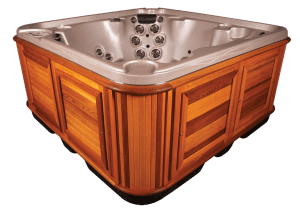What To Know When Buying A Spa
 Tips on how to determine the right spa for you and your budget.
Tips on how to determine the right spa for you and your budget.
Shell:
The spa shell is one of the most important parts to consider when purchasing a spa. Other elements, such as pumps or heaters, are fairly easy to repair or replace if something goes wrong. However, if the spa shell malfunctions, more than likely the entire spa will have to be replaced. Fiberglass is the best material for a spa shell. Fiberglass is 9 times stronger than steel and allows heat to transfer through the shell both ways to heat the cabinet as well as the water in the tub (as long as the shell itself is not insulated). Since the spa shell is the most important part of your hot tub, it should be considered a top priority to research the manufacturer’s shell warranties. Always understand that a warranty is only as good as its manufacturer. You should take into consideration both the longevity and service history of the manufacturer and the retailer selling you the tub. Comfort is a top priority in choosing a spa, so choosing the proper seating design is crucial. Although lounge seating can restrict the number of seating areas in a spa, most people prefer a lounge because of the comfort it provides. It offers the luxury to lay back and recline the entire body for complete relaxation. Therapy seats are designed to offer a full body massage. In one seat, jets can massage your neck, back, shoulders, arms, thighs, knees, calves, and feet. For added comfort, look for a molded therapy seat, such as a captain’s chair.
Cabinet:
Since the first thing people notice when they see a spa is the cabinet, it is best to use a high-quality wood to enhance the overall look of your hot tub. Western red cedar is best in hostile environments (i.e. colder climates), where it fights to survive with other plant life and vegetation. This helps it to build tremendous strength, while also developing into a very durable and weather-resistant wood. Many up-scale home builders use western red cedar because it easily stands up to the abuse from nature’s elements, while still providing an elegant appearance. Western red cedar also keeps bugs (i.e. bee’s, ants, termites, etc.) away from your tub as they do not like the smell or taste of the cedar. Another extremely important feature of a spa is to have removable wall panels. This gives you the ability to remove the walls from the spa in case repairs are needed. Just imagine trying to repair a car without having the ability to lift or remove its hood. The repairing process becomes nearly impossible, extremely time consuming, and expensive. With this design, your spa can be easily checked and serviced when needed.
Insulation:
Insulation is one of the most important aspects to consider when purchasing a spa. It is the part of the spa’s design and construction that will most determine the cost of operation. Imagine two spas identical in size, holding the same amount of water, located in the same backyard, used identically, but that have dramatically different operating costs. How could one of these spas cost as little as $15 per month to operate, while the other exceeds $100 per month? The difference is due to the method and type of insulation. No matter what type of insulation is used, as long as some form or method is employed, it will assist in reducing the operating cost of the spa. By incorporating insulation into the spa structure, the manufacturer is reducing the time it takes for the water temperature to pass from the body of water to the outside environment. There are basically 2 types of insulation to consider. The first and most energy efficient is “heat lock” insulation. With heat lock, the insulation is around the top of the spa cabinet, the walls of the cabinet, and the floor of the cabinet. What heat lock does is allow the heat from the spa’s cabinet to transfer through the shell and into the water which allows you run the heater less. It also works backwards allowing the hot water in the spa to transfer through the shell to the cabinet keeping the inside warm. Another great feature of the heat lock system is it makes it a lot easier to and more cost effective to service the spa because you don’t have foam to dig through to find a leak. The other type of insulation is full foam insulation which consists of filling the area between the shell and cabinet sub floor completely with a thick layer of solid, rigid foam. Over 70% of spas manufactured today use this method of insulation. Each of these factors will help determine the cost to operate your spa, and will influence the effectiveness of the type of insulation that you choose. Just remember that once you have your spa, it is impossible to change its method of insulation.
Floor:
The floor is the foundation of your spa. The floor is just as important as all of the features above and maybe a little more. There are basically two types of flooring; wood and fiberglass. Fiberglass floors are preferable to wood floors because they protect the spa from the elements, they make your spa portable, they allow you to place your spa on any level surface, without a cement pad, and they seal up your spa so that rodents cannot get into your spa cabinet.
